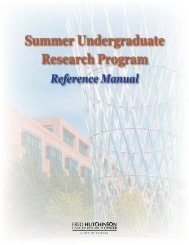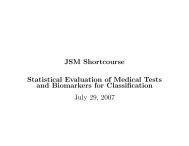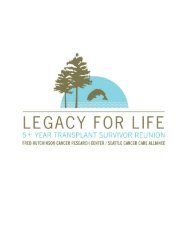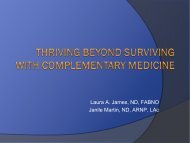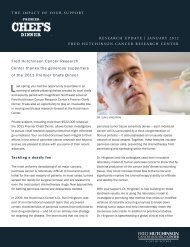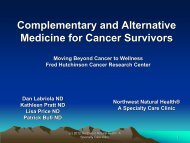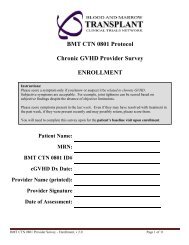discovery - Fred Hutchinson Cancer Research Center
discovery - Fred Hutchinson Cancer Research Center
discovery - Fred Hutchinson Cancer Research Center
Create successful ePaper yourself
Turn your PDF publications into a flip-book with our unique Google optimized e-Paper software.
6<br />
Richard Nash, M.D.<br />
Immunotherapy <strong>Research</strong>er/Oncologist<br />
L E U K E M I A T R E A T M E N T S H O W S P R O M I S E<br />
FOR SYSTEMIC AND MULTIPLE SCLEROSIS<br />
As a hard-working member of the immune system, a T-cell<br />
is an efficient killer, attacking anything it perceives as an<br />
intruder, whether it’s a virus-infected cell, a cancer cell or a<br />
bacterium.<br />
But sometimes, a T-cell attacks a friend—and it goes on<br />
attacking, unchecked, destroying healthy tissue and creating<br />
serious autoimmune diseases such as multiple sclerosis and<br />
lupus. Why the immune system goes so<br />
very wrong has puzzled researchers<br />
for decades.<br />
As many as 80 autoimmune diseases<br />
have been identified, and some of<br />
them are capable of causing serious<br />
complications, even death. One<br />
example is systemic sclerosis (also<br />
known as scleroderma), a disease without<br />
effective treatment. “It’s one of the<br />
most frustrating diseases to treat. There’s<br />
high mortality and no therapies, and it<br />
can hit you in so many ways,” said<br />
Dr. Richard Nash.<br />
By training, Nash is an oncologist,<br />
a researcher in leukemia and other blood cancers. But thanks to<br />
a unique and unexpected insight, he’s now applying his knowledge<br />
in whole new ways. Along with colleagues, he is taking the<br />
<strong>Hutchinson</strong> <strong>Center</strong>’s pioneering leukemia research and applying<br />
it to other diseases, such as systemic sclerosis and MS.<br />
The standard treatment for leukemia and other blood<br />
cancers is chemotherapy, radiation and transplantation of<br />
bone marrow or blood stem cells. Nash is optimistic the same<br />
approach may now help patients with autoimmune diseases.<br />
It has taken some very unlucky patients—a rare few who<br />
had both leukemia and systemic sclerosis—to uncover a<br />
potential new use for transplantation.<br />
With systemic sclerosis, a patient’s skin becomes very hard,<br />
severely limiting movement. When one<br />
of these patients received a stem cell<br />
transplant for cancer, “we saw evidence<br />
of skin improvement. The treatment<br />
suggested that the fibrosis of the skin<br />
was a reversible condition,” Nash said.<br />
“And it appeared to stabilize<br />
the organs.”<br />
With transplantation, it may be<br />
possible to remove the reactive cells that<br />
are triggering the immune system to<br />
attack the body. Currently, Nash’s lab<br />
is conducting three clinical trials to<br />
evaluate the safety and effectiveness<br />
of high-dose chemotherapy and<br />
stem-cell transplantation for systemic sclerosis and MS.<br />
“For me, that’s part of the excitement of being in this<br />
field … we’re doing something different and helping people,<br />
and learning about potential new therapies. To be successful<br />
in any project, collaboration and teamwork are very<br />
important,” he said.<br />
A BRAIN SCAN SHOWS MULTIPLE SCLEROSIS LESIONS THAT COULD BE IMPROVED WITH T-CELL THERAPY.




